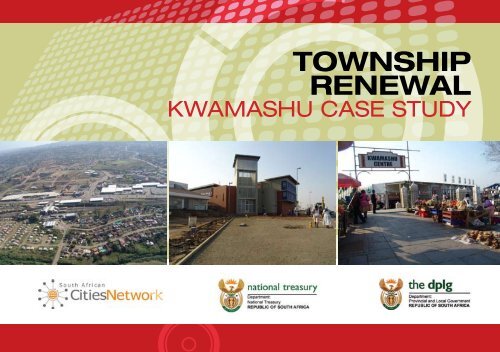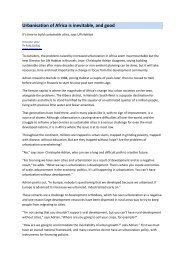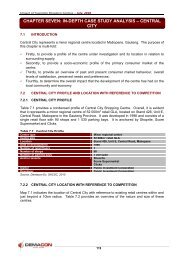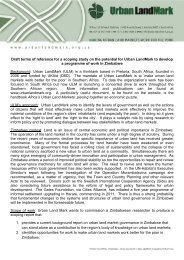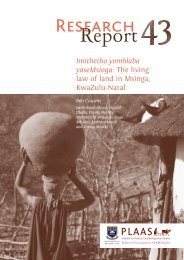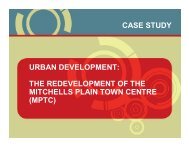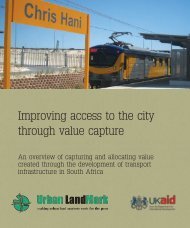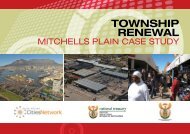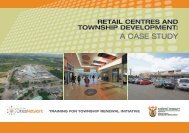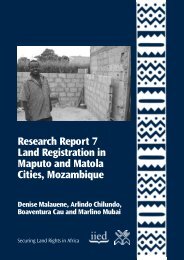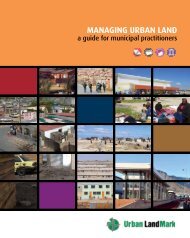KwaMashu Town Centre - Urban LandMark
KwaMashu Town Centre - Urban LandMark
KwaMashu Town Centre - Urban LandMark
- No tags were found...
You also want an ePaper? Increase the reach of your titles
YUMPU automatically turns print PDFs into web optimized ePapers that Google loves.
deeds of grant, which in effect are longtermleases. The lack of private ownershipprovided a strong disincentive for propertyimprovement of any kind.Political contextThere was a high level of civic organisationand participation, with a strong politicalcomponent. Most ward councillorsbelonged to the African NationalCongress, making the area more politicallyhomogenous than some other parts ofKwaZulu-Natal.Social contextThe area was characterised by highunemployment and a low skills base. Thelonger-term consequences of the politicalviolence of the 1980s included high levelsof crime and insecurity, and the absenceof any tertiary education institutions.Business and investment contextMost of the shops in <strong>KwaMashu</strong> weredestroyed in the political turbulence ofthe 1980s. There had been a prohibitionon white capital investment in townshipsduring the apartheid era. Apart fromthe Ithala Shopping <strong>Centre</strong>, there weresimply no business premises available.People engaged in economic activity onpavements, or illegally in back yards, inroad reserves or on unused land. The lackof secure title to land was a disincentive tobusiness investment – the land could notbe used as collateral for a loan, and anyimprovements would be forfeited to thelandowner at the end of the lease. Apartfrom some local traders’ associations, therewere no structures representing formalor informal business across <strong>KwaMashu</strong>,making it difficult to engage withbusinesspeople on proposed economicplans and development opportunities.Problem statement<strong>KwaMashu</strong> faced a number of problems,some of them interrelated:• The town centre planned for <strong>KwaMashu</strong>from the mid-1950s had never developed.• There was a lack of investment, bothpublic and private.• Residents had to travel long distances toaccess facilities, goods and services.• Public transport infrastructure waspoorly developed.• There was a lack of security, socialinfrastructure and recreation facilities.• There was a high level of economicleakage – very little of the money earnedby residents was spent or circulatedwithin <strong>KwaMashu</strong>.• The lack of businesses and support meantexisting enterprises struggled to grow.• There was no security of tenure.• There was a lack of pride amongresidents in their neighbourhood.PlanningA multidisciplinary consultant team wasappointed to:• Scan <strong>KwaMashu</strong> to identify economicand development opportunities.• Research best-practice models andintervention strategies to establishwhether concentrating the facilities inone node was the best strategy.• Consult with political structures andcommunity forums, trader associations,local businesspeople and outside investors.• Develop plans for three areas ofintervention (upgrading infrastructure;improving safety, security and socialinfrastructure; and supporting thegrowth of existing businesses and theestablishment of new ones).• Recommend whether the project shouldbe implemented by an agency orthe municipality.The eThekwini municipality opted to drivethe project, focused on a single nodeimplemented by a project managerand supported by line departments.The KMTC project began in 1999.Subsequent developments were theidentification of INK as a Presidential LeadProject of the <strong>Urban</strong> Renewal Programme,and the establishment of the eThekwiniINK Area-based Management Unit.Targeted outcomesThere were four targeted outcomes:• To create an enabling environment forlocal businesses to grow, for the residentcommunity to prosper, and to attractoutside investors.• To transform <strong>KwaMashu</strong> into a thrivingcentre with its own economic drive andsocial vitality.• To offer residents a quality urban living,working and recreational environment.• To link this envisaged urban centre backto the city.Key project objectives to achieve thetargeted outcomes were: to achieveeconomic regeneration by creating4 5
an environment conducive to businessgrowth; and the provision of security andsocial infrastructure to create a safe andsecure environment for residents to live,work and play in.Intervention logicMobilising and focusing public andprivate-sector investment was pivotalto establish a properly functioningproperty market. Changing the landtenure to freehold would not have beenenough to achieve this goal, but was anecessary precondition.A nodal focusActivities had a nodal focus – that is, theywould be clustered around the point ofhighest accessibility to achieve maximumimpact. The purpose was to bring residential,business, work, goods and services, transport,recreation and entertainment opportunitiestogether in one place.Obtaining and sustaining buy-inand supportSteps were taken to ensure sustainedbuy-in from politicians and communitystakeholders. The project steering committeeis chaired by senior local councillors. At thebeginning of the project, public meetings,workshops and briefing sessions were heldto discuss various options. The choices madeat these events were crystallised into acommonly held vision for <strong>KwaMashu</strong>. Theseinteractions were guided by a problemsolvingapproach, and were intended toachieve clarity on roles, responsibilitiesand the process to be followed. Sustainingbuy-in is dependent on visible delivery, andbeing willing to accommodate the interestsand concerns of stakeholders, even if theygo beyond the strict boundaries of whatmunicipalities usually do.The KMTC project team has ‘gone theextra mile’ to ensure good communityrelations, as the following example shows.The Shembe church had established anopen-air temple on land in the town centrethat was subsequently earmarked for anew clinic. There was no physical structureon the site – the temple was simply markedout by white stones on the ground – but theground was sacred nonetheless. When thechurch elders found out about the plans forthe clinic, they asked to buy the land.The KMTC project team could simplyhave told the church to leave becauseit was occupying the land illegally and hadno tenure. But in the spirit of maintaininggood relations with the community, theteam followed a consultative approach. Theproject manager requested an audiencewith the prophet of the Shembe, with all theappropriate ritual observances, to requesthim to deconsecrate the land and movethe temple. The prophet agreed to movethe temple if the project team helpedthe church to find and buy an alternativepiece of land. A horticulturalist was hiredto transplant sacred trees to the new site.This was the first time that the Shembe hadagreed to move one of their temples.The KMTC project team was willing toaccommodate the needs of thiscommunity stakeholder, and had theauthority to make an undertaking thatwould make agreement possible.The KMTC project has been able tomaintain sustained buy-in and supportas a result of the high level of civicorganisation participation, with strongward councillor involvement, and the factthat most ward councillors belong to asingle political party. A Community PolicingForum is in operation and a Lot Owners’Association has been proposed.A facilitative, open approachThe KMTC project has been guided byseveral underlying principles:• An open-ended approach, guided bythe question: What will have the greatesteconomic impact in this region?• Planning from ‘first principles’– taking the broadest possible view tocontextualise the project and guidelocal planning.• Being flexible with regard to layout(so that it could easily be changed tosuit new demands) and zoning(to permit multiple land-uses).• Adopting a facilitative role to takeresident and investor concernsinto account.Specific interventionsTenure upgradeThe old land tenure system was upgradedto make it possible to own land in KMTC.A new subdivisional layout was3The first application was granted in 2003, and two amendments were granted in 2005.introduced, combining a number oflarger plots to offer a broader range ofmore suitably sized sites, ranging from450m 2 to 1 000m 2 . A land sales registerwas established to make it possible to selland transfer ownership of land.Figure 4: KMTC precinct planCreating a suitable planning frameworkAn application was made under theDevelopment Facilitation Act to create atown planning layout for the town centre,zoning and development regulations,and the basis for a new general plan andthe sale of land with full freehold title. 36 7
Development guidelines and precinctplans were developed for mixed-usebusiness; mixed-use residential; sport,recreation and leisure; commercial andlight industrial zones.Infrastructure upgradeImproved access: Malandela Road – themain access road to <strong>KwaMashu</strong> – wasupgraded. Ubhejane Road was extendedto link <strong>KwaMashu</strong> with Bridge City, the newregional centre 2km from KMTC. UndlondloRoad was improved to provide access tothe Princess Magogo Stadium. In addition,internal service roads and pedestrianwalkways were built.Serviced land for development:Water-borne sewerage, water, electricityand road access have been provided todevelop land packages for private-sectordevelopment.Sport, recreation and leisure: The PrincessMagogo Stadium is being upgraded tobecome one of three 2010 soccer WorldCup training venues in Durban. A sportand recreation precinct plan is in placefor further development of an activerecreation area in this vicinity. Park andleisure facilities have been provided.Improved safety and securityThe new Metro Police station hasestablished a police presence.The fact that it is a three-storey buildingin a prominent location has created theperception of a safer environment.Security by design principles are beingused to avoid dark spots, cul de sacsand other danger spots. The buy-in ofthe Community Policing Forum wassecured for the KMTC redevelopment, aprocess which assisted in reactivatingthe forum. The proposed Lot Owners’Association is likely to become part ofthe institutional arrangements forprecinct management.Social servicesThe provincial Department of Health isbuilding a large new clinic in the towncentre. The provincial Department of SocialWelfare is considering building a newregional office and pension payout point.There is also a possibility that the nationaldepartments of Home Affairs and Labourmay build new offices in <strong>KwaMashu</strong>,reducing the need to travel long distancesto access government services.Support for businessThe KMTC initiative sought to support thegrowth of existing businesses and to fosterthe establishment of new ones throughtargeted interventions.Small business: Support at the small endof the business spectrum took the form ofproviding a range of subsidised municipalfacilities, including upgrading the StationTraders’ Market; redeveloping the oldMahawini Small and Medium Enterprise(SME) Hive to become a retail incubatorfacility; and improving and regulatingstreet trading facilities. Steps were taken toensure that municipal contracts allocate20 per cent of labour and subcontractingcomponents during construction phasesto local businesses.Medium-sized business/ mixed-useresidential: Support at the mediumenterprise level took the form of preparing a6ha parcel of land for sale and subsequentdevelopment for mixed business andresidential use. Opportunities includedrental business space of varying size andstandard; sale of sectional title businesspremises; sale of complete businessbuildings; and share equity options. Thepart zoned for mixed-use business allowsfor buildings of up to six floors; the partzoned ‘mixed-use residential’ allows for upto three storeys, with business/office use onthe ground floor and residential units on theupper floors.Commercial business: The project teamtook steps to facilitate the establishmentof a larger commercial development.The <strong>KwaMashu</strong> Shopping <strong>Centre</strong> wasan early private-sector investment worthR75 million, which provided a high-qualityshopping environment featuring a rangeof major chain stores and banks. Thiswas a catalytic development that shiftedperceptions of the area among locals andoutsiders. It attracted people to the towncentre, which improved the market forlocal small and medium-sized businesses,stimulated investment interest and creatednew business and job opportunities.Small-scale manufacturing: A constrainton business development in <strong>KwaMashu</strong>8 9
is over-reliance on retail and services ina limited market. There is also a lack ofland and premises for manufacturingand skills development. The projecthas responded to this by planning amunicipal mini-factory complex to fostersmall-scale manufacturing, with a focuson furniture and allied manufacturingtrades (wood and steel). The SmallEnterprise Development Agency (SEDA)entrepreneurial support centre in<strong>KwaMashu</strong> provides specialised skills andbusiness development training as well aslinkages with markets.Lessons about publicsectorinvestmentMetro Police stationThe eThekwini Metro Police were lookingfor a site for the new northern regioncommand centre. The project teamgrasped this opportunity to improve safetyand security by persuading the MetroPolice to site the station in the <strong>KwaMashu</strong>town centre. Maximising this opportunityrequired locating the station on a site thatwould be visible from some distance, andthe project team identified a strategic siteowned by the municipality. Ithala donatedan even better site for the police stationon the corner of two of the busiest streetsbecause its own work in <strong>KwaMashu</strong> wouldbenefit from better security. Althoughattempts were made to encourage theMetro Police and the South African PoliceService to share one facility, these werenot successful.In this case, the project team wassuccessful because they wereopportunistic and persuasive. Theimprovement of safety and security wasan important catalytic investment thatstimulated the interest of other public andprivate investors.Provincial ‘mega-clinic’There were three existing provincialDepartment of Health facilities in<strong>KwaMashu</strong> – a polyclinic and two smallerclinics. However, these were inadequate forthe needs of the area, and badly in needof upgrading. When departmental officialsfound out that work on the town centrehad commenced, they approached theKMTC project team to make available asite for a new community health centre.This is referred to as a ‘mega-clinic’because it provides the services of aLevel 1 hospital, excluding overnighthospital beds. The municipal site thatthe department wanted was zoned fora different use.The provincial Department of Healthsecured national government budgetapproval for three new health facilitiesin INK as part of the <strong>Urban</strong> RenewalProgramme, one of which was theproposed mega-clinic in <strong>KwaMashu</strong>.Once approval was received, the KMTCteam rezoned the land for a health facilityand facilitated its sale to the provincialgovernment. The provincial Department ofHealth appointed Ithala to manage theimplementation of the project, which iscurrently under construction.The KMTC project team decided to startimplementation on the roads componentof the project – to ‘start putting spades inthe ground’ on an aspect of the plan thatwas unlikely to change. This stimulated theinterest of the Provincial Department ofHealth, as well as other public and privateinvestors. The investment was secured byan opportunistic decision to rezone theland, but only once national governmentapproval for the construction of the megaclinicwas in place.Other government officesThe provincial Department of SocialWelfare approached the KMTC projectteam for land to build a new regionaloffice and pension payout point. The teamoffered to sell a site to the departmentfor this purpose, but progress has been10 11
stalled by staff resignations and delays inthe provincial land acquisition process.The time limit on mandate to sell hasexpired more than once. A key problem isthe lack of a champion within the SocialWelfare Department. There is a possibilitythat the national departments of HomeAffairs and Labour may build new officesin <strong>KwaMashu</strong>, but neither departmenthas made a clear decision.The development of Bridge City as a newregional node for the whole INK area,2km from KMTC, may reduce the ability ofthe KMTC project to attract governmentdepartments to the town centre.The danger is that there may be too manynodes, or that the lack of shared objectivesin respect of the delivery of governmentservices may mean that nodes competewith, instead of complementing, oneanother. The Bridge City project hasproposed the establishment of agovernment services mall.the former townships. The project teamconvinced the developer to investigatethe KMTC opportunity, supported by aclear picture brochure and data aboutdisposable income, thresholds andeconomic viability. The team and companyrepresentatives explored a number ofparcels of land owned by the municipality.However the developers were interested ina different area that included some landparcels not owned by the municipality.The team decided to support this initiativebecause they saw it as a catalyticdevelopment.A key challenge was related to landassembly – acquiring the parcels ofland necessary to make up the site thatthe developer wanted. The developersapproached the holders of the relevantdeeds of grant and negotiated to‘purchase’ the lease. There were difficultieswith locating owners and establishing aprice, including establishing the quantumof rates arrears on the property.But the leases were duly purchased.The municipality sold a piece of landrequired to complete the parcel by privatetreaty to support the development. 4At the time the land assembly processstarted, there was no town planningscheme to make developments of thiskind possible, and no private ownershipof land was possible. In 2003, the KMTCproject team launched an applicationunder the Development Facilitation Actto put in place a town planning layoutfor the town centre, together with zoningand development regulations, and thebasis of a new general plan and the saleof land with full freehold title. In 2005, theteam launched an application for anamendment to the zoning scheme thatwould allow the land assembled for the<strong>KwaMashu</strong> Shopping <strong>Centre</strong> to be used forthat purpose.<strong>KwaMashu</strong> Shopping <strong>Centre</strong>A scout working for a private-sectordevelopment company was looking foropportunities to establish a presence in4The Municipal Finance Management Act requires that municipal land be sold by tender, unlessthere are good reasons to deviate from this principle. In this case, the land could be sold by privateagreement because it is expensive to develop – it contains a stream and the underlying rocks are shale– and because it was in the public interest to facilitate the development of a major shopping centre.12 13
A tenure upgrading process was takingplace at the same time to survey the landon the original town plan, consolidatecertain parcels and subdivide others,and register the land in the deedsregistry. This was essentially catching upon what government failed to do whenit established the township in the 1950s.Once the land was properly registered inthe deeds office, it was possible to havefreehold ownership. Without tenure security,there would have been limited privatesectorinvestor interest.A key determinant of investment wassafety and security. The fact that the MetroPolice station was being built close to theshopping centre site was a key factor inthe developer’s decision to proceed.Because shopping centres generate largeamounts of traffic, municipal approvalpartly depends on sufficient developerinvestment in road improvements androad safety. The planned entrance to theshopping centre was at a dip in the road.This is a road safety hazard that would,under other circumstances, have to becorrected at the developer’s expensebefore planning approval could beobtained to proceed. In the <strong>KwaMashu</strong><strong>Town</strong> <strong>Centre</strong> case, this additional expensewould have caused the developer towithdraw. The KMTC plan had always beento upgrade the road at a later stage atmunicipal expense. In view of the catalyticimportance of this proposed development,the project team switched infrastructurefunding allocation priorities to fill in thedip immediately as part of the upgradingof this section of Malandela Road.This secured the investment.Property investment decisions are basedon market cycles. There are good andbad times to invest. The shopping centredeveloper’s message to the project teamwas that it would invest if the centre couldbe opened by December 2005. If thatwere not possible, the planned investmentwould be withdrawn. On the basis of firmcommitments from the project team,the developer started work on theshopping centre.The project team’s attitude in this casewas that it would work with the developerto ensure everything would be done tosecure the complex. In parts of the citywhere the land market works properly thiswould not have been necessary. But a keypart of establishing a functioning propertymarket is mobilising investment, and thisparticular investment was significant – aR75 million 11 000m 2 shopping centre, withsubstantial anticipated catalytic effects.The key points relevant to private-sectorinvestment from this experience are:• Being able to quickly and clearlycommunicate the situation to an investor.• The importance of a flexible response toland assembly constraints.• The importance of a predictable landlegal framework.• Flexible, adaptive and responsiveplanning.• Understanding the long-term propertyinvestment cycle and respondingappropriately.• Ensuring investment in safety and security.• Being willing to undertake road andpublic environment improvements atmunicipal expense, and providing a safeenvironment at the same time.Mixed-use residential investmentThe mixed-use residential investmentcomponent was intended to provideprivate-sector opportunities in the ‘gap’housing market. This market segment iscomposed of people who earn morethan the income ceiling for a subsidisedgovernment house, but too little to buyinto the formal housing market – definedas people earning a combined income ofbetween R7 000 and R15 000 a month.The KMTC project team had preparedplots for freehold title, zoned the land formixed use, provided bulk services, andhanded it over to the municipality to sellby public tender. The team recommendedsplitting the land into smaller parcels andawarding these to a range of bidders. Thiswould have resulted in more than one kindof housing option, and would have spreadthe risk. But the council decided to awardthe entire parcel to a single bidder.Had the land been packaged in smallerparcels, these could have been releasedone at a time, increasing the chances thatmore than one developer would be activein the market. This would also have madeit possible to test market interest withoutrisking the entire parcel.While there was a strong interest amongbidders in the housing component of the14 15
mixed-use plan, there was little interestin the business component. The lackof interest in business property may berelated to the economic downturn. If thehousing and business components of thepackage had been packaged separately,it would have been possible to hold backthe business component until the marketimproved. Market analysis would havebeen useful to guide the packaging andrelease of land.A key part of mobilising private-sectorinvestment is trust among bidders thatthey stand a fair chance of being selected.A more strategic approach to packagingthe land parcels would have increased thenumber of opportunities for developers.Light manufacturingIt is relatively easy to achieve theeconomic objectives of pluggingeconomic leakage, and creating localjobs and investment opportunities, throughretail investment. However, the benefits arelimited, especially considering that most ofthe stores in shopping centres are nationalchains whose head offices are locatedelsewhere. There is also competitionamong the INK nodes to tap the retailmarket and a saturation point will rapidlybe reached.Manufacturing is a more effective jobcreator than retail, and it is more effectiveat countering economic leakage. Areaslike <strong>KwaMashu</strong> are in essence residential,so it is unrealistic to expect significantindustrial investment. But there arealready a range of activities, mostlyinformal, in the small-scale manufacturingand service industries.There is a strong pavement industry in,for example, manufacturing steel gatesand burglar bars, and repairing exhausts,tyres, fridges, upholstery and awnings.There are many traditional healers, somewho dispense their own medicines andothers who give prescriptions to be filledby herbalists. A constraint on the growth ofthis sector is the lack of suitable businesspremises. One response to this has beenillegally parking shipping containers on theverge for storage. Three-phase electricity isrequired for certain industries that currentlydraw electricity from local houses, with allthe accompanying hazards.The station traders’ market offers a rangeof other activities, e.g. fruit and vegetables,live poultry, and fresh or cooked bovineheads. The market has concrete tablesand a metal roof, and shipping containersare used as storage, even for live chickens.There is a lack of cold storage, electricity,drainage and washing facilities. The sewerseasily become blocked because there areno grease traps.A major upgrade of the traders’ marketis being done with lockup stalls that aresupplied with electricity and water. Therewill be a secluded place for choppingup bovine heads, linked to shops that sellthe fresh and cooked meat. Electricity willmake it possible to store meat in deepfreezers. Conditions will be more hygienicand secure. The KMTC team planned toincrease the size of the market by adding25m 2 shops to cater for service industriessuch as hair salons, real estate agents,photographers and traditional healers.After further consultation, the team agreedto reduce the size of these shops to 15m 2 ,a size which attracts a rental of about R160per month.There is little private-sector interest in thissector, but it is important nonetheless, sogovernment support is necessary. The KMTCproject aims to facilitate the developmentof these activities by identifying lightmanufacturing opportunities, makingmunicipal land and facilities available, andsupporting skills development.A rezoning and environmental impactassessment is being done on a pieceof land just outside the town centre, butstill in the main thoroughfare, for the16 17
establishment of an SME business parkand skills development incubator in thewood and furniture sector. A portion ofthat site will be released to the privatedevelopers’ market. This business park willbe a cluster of mini-factories with rentablepremises ranging in size from 25m 2 to100m 2 . Enterprise support is available fromthe SEDA business support centre.The KMTC team is in negotiations aboutthe proposed incubator with FurnTech,a Section 21 company established bymajor furniture industry players to supportemerging businesses in the sector.This part of the KMTC project is at an earlystage. The proposed incubator showsthat there is some potential for matchingcorporate social investment needs withsmall business development.ResultsPositive:• Infrastructure and engineering serviceshave been upgraded (R58 million).• A planning framework and zoning andregulatory frameworks have been putin place.• A number of the important road linksto other economic centres, and linksFigure 5: KMTC in 1999 Figure 6: KMTC in 2007to existing railway stations, have beenupgraded.• 6ha of prime housing land is ready to besold and developed.• A Metro Police station has been built andbrought into operation (R13.5 million).• A provincial Department of Health ‘megaclinic’is under construction (R80 million).• A high-grade shopping centre hasbeen built and is trading successfully(R75 million).• Three municipality-led small, mediumand micro-enterprise projects have beenplanned and are under way.• Major sport and recreation facilitieshave been planned and are underconstruction.• The National Treasury has allocateda Neighbourhood PartnershipDevelopment Grant to the project(R62 million).• A community court has been establishedat <strong>KwaMashu</strong> police station.• A solid waste recycling centre hasbeen established.Uncertain:• The mixed-use development model is stilluntested in the local market.• The long-term sustainability of municipalfacilities is uncertain – maintenance,management and enforcement areproblematic.• Few local traders are on an upwardentrepreneurial trajectory.• Development processes are open topolitical manipulation, regardless of howgood the technical work may be.Lessons learntA number of key lessons about mobilisingand focusing capital investment can bedrawn from the <strong>KwaMashu</strong> <strong>Town</strong> <strong>Centre</strong>experience.Select a good location: The <strong>KwaMashu</strong>town centre was a large, well-located tractof undeveloped land that already hadlarge number of people passing through,and was highly accessible to train, busand taxi commuters.Make sure the land is owned andcontrolled by the implementing authority:The <strong>KwaMashu</strong> <strong>Town</strong> <strong>Centre</strong> site wasowned by the state, and devolved to theeThekwini municipality.Deal with land issues early on: The tenurearrangements in respect of vacant landthe municipality intended to bring to themarket were insecure (deeds of grant).These had to be upgraded to freehold toallow the land to be sold and transferredto private owners. This upgrade had theeffect of stimulating investor interest andcontributing to the development of afunctioning property market.Use a flexible and adaptable framework.The KMTC project team opted to use avery generic type of zoning that wouldallow a broad range of different activities.Although the team knew which elements18 19
they wanted in the town centre, theyavoided zoning specific parcels of land forspecific purposes. Where the zoning didnot permit a desirable land use, the zoningwas changed.Employ a holistic and facilitativeapproach: Project managers shouldtake a wide view of their responsibility,and be willing to deal with anything andeverything that they have an influenceover, even those things they did not planto do. They must be willing to go theextra mile to deal with the concerns ofresidents and investors, including historicalgrievances.Ensure and sustain political communitybuy-in and support: This implies havingdone vision-building and planning withstakeholders; securing political support;working to accommodate the needs andconcerns of stakeholders; and having thewillingness and authority to engage withstakeholders.Pay attention to good intergovernmentalrelations: The KMTC project was amunicipality-led intervention thatsought to mobilise investment within themunicipality (e.g. the Metro Police station),at the provincial level (e.g. the provincialDepartment of Health mega-clinic), andat the national level (e.g. the NationalTreasury Neighbourhood PartnershipDevelopment Grant).Devise strategic ways to package land:Technical proposals should be backed bystrategic packaging of land parcels, andmarket analysis to guide the packagingand release of land.Respond to private-sector investmentrequirements: This includes a flexible andresponsive approach to land assemblyconstraints; establishing a predictableland legal framework; responding to theproperty investment cycle; investing insafety and security; and providing roadand public environment improvements.Make a start, knowing that some mistakeswill be made: The KMTC team kick-startedthe project by upgrading roads becausethey knew those components of the planwould not change. Once people saw thatthe work on the ground had started, theyknew the project was real, not simply planson paper. This, and the fact that they couldsee the momentum being maintained bya dedicated project team, triggered theinterest of the shopping mall developerand the provincial Department of Health.20 21


